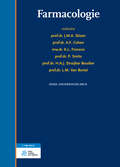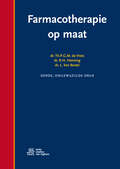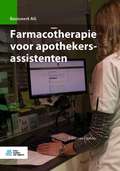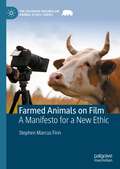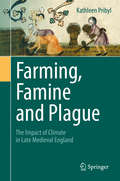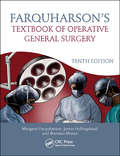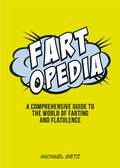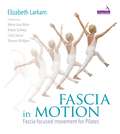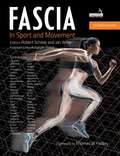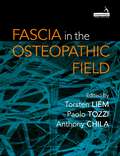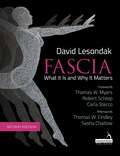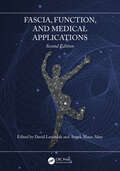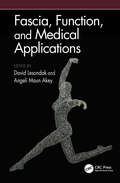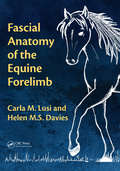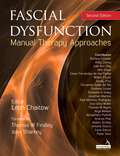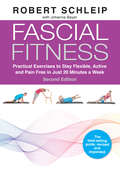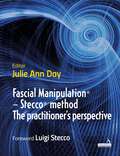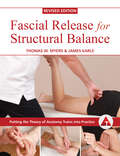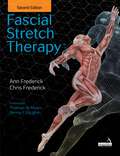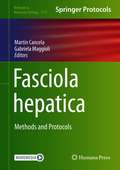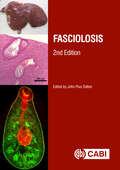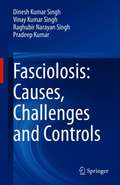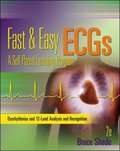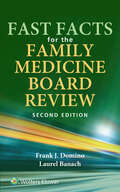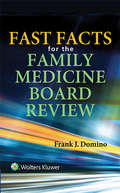- Table View
- List View
Farmacologie
by J.M.A. Sitsen A. F. Cohen K. L. Franson P. Smits H.A.J. Struijker Boudier L.M. van BortelFarmacologie voorziet bij uitstek in de behoefte aan een Nederlandstalig leerboek dat aansluit bij de Nederlandse geneeskunde. In dit leerboek wordt het klinisch belang van de leerstof uitgebreid toegelicht en benadrukt.Farmacologie biedt een overzicht van de belangrijkste onderwerpen uit de medische farmacologie. In de tekst zijn kaders met trefwoorden opgenomen, waardoor de student zich de termen en onderwerpen gemakkelijk eigen maakt. Bovendien wordt het geheel van de stof hierdoor overzichtelijker.Farmacologie is een medisch vakgebied dat voortdurend in beweging is en ook in de toekomst een belangrijke rol zal spelen. Daarom is in dit boek naast de leerstof ook leesstof opgenomen, waarin zowel naar de geschiedenis wordt gekeken als gespeculeerd wordt over de toekomst van de farmacologie. Het boek is geheel bijgewerkt naar de huidige stand van zaken. Nieuwe inzichten en geneesmiddelen zijn opgenomen en er is ook aandacht besteed aan weesgeneesmiddelen en monoklonale antilichamen. Het boek is uitgebreid geïllustreerd met full-color figuren van het Teaching Resource Centre van de Universiteit Leiden. Aan deze druk is een onlineomgeving toegevoegd: Studiecloud. De lezer kan via deze internetsite voortdurend beschikken over dit aanvullende materiaal zoals extra oefenvragen, samenvattingen en deep links met betrouwbare informatie, samengesteld door de auteurs van het boek.
Farmacotherapie op maat
by R. H. Henning Th.P.G.M. de Vries L. M. van BortelFarmacotherapie heeft de optimale behandeling van patiënten met geneesmiddelen tot doel; er wordt gestreefd naar farmacotherapie op maat. De kennis van ziekten en geneesmiddelen is aanzienlijk gegroeid, evenals het aantal geneesmiddelen. Enerzijds is daardoor therapie op maat beter mogelijk, anderzijds maakt dat het keuzeproces complexer. Formularia, protocollen en standaarden bieden houvast, maar het persoonlijk oordeel van de arts over de behandeling van elke individuele patiënt blijft doorslaggevend.Farmacotherapie op maat geeft een beschrijving van een praktische methode. Deze is gebaseerd op de succesvolle WHO Guide to Good Prescribing en voor de Nederlandse en Belgische situatie aangepast. Hoofdstuk 1 beschrijft de basis: de interactie tussen patiënt en geneesmiddel, de grondslag voor de farmacotherapie op maat. Hoofdstuk 2 behandelt de voorbereiding: de manier waarop een (persoonlijk) formularium met basisgeneesmiddelen kan worden verkregen. De behandeling van patiënt met de basisgeneesmiddelen wordt in hoofdstuk 3, het stappenplan, beschreven. In hoofdstuk 4 wordt de methode aan de hand van twee voorbeelden geïllustreerd.In deze tweede druk zijn in het bijzonder de mogelijkheden van het internet aangegeven bij het kiezen en voorschrijven van geneesmiddelen.Farmacotherapie op maat is primair geschreven voor studenten geneeskunde, physician assistant en gezondheidswetenschappen, en voor docenten die overwegen hun onderwijs in farmacologie en farmacotherapie te veranderen. Ook ervaren artsen kunnen dit boek gebruiken bij nascholingsactiviteiten en om hun voorschrijfgedrag te evalueren.
Farmacotherapie voor apothekersassistenten (Basiswerk AG)
by F.A.C. van OpdorpIn dit boek wordt de wijze waarop geneesmiddelen werken, hun bijwerkingen en hun wisselwerkingen met de patiënt en met andere geneesmiddelen beschreven. Er wordt uitgebreid ingegaan op de plaats die de geneesmiddelen innemen in de behandeling van uiteenlopende ziekten, van reuma tot slaapproblemen, van infectieziekten tot depressies. Daarnaast wordt in het boek veel aandacht besteed aan de noodzakelijke informatie die apothekersassistenten aan de balie moeten verstrekken. Er wordt antwoord gegeven op de volgende vragen: Wat zijn de klachten? Om welke aandoeningen gaat het? Welke medicijnen worden hiervoor het meest gebruikt? Welke bijwerkingen hebben de verschillende geneesmiddelen? Wat zijn de belangrijkste contra-indicaties en interacties?Farmacotherapie voor apothekersassistenten bestaat uit twee delen. In het eerste deel worden de farmaceutische basisbegrippen in de apotheek behandeld. In het tweede deel komt de farmacotherapie in de apotheek uitgebreid aan bod. In deze uitgave zijn alle hoofdstukken aangepast aan de nieuwe standaarden en richtlijnen. Verder worden de nieuwste geneesmiddelgroepen beschreven. De inhoud sluit met name aan bij de beroepsspecifieke onderdelen ‘Voert geïndividualiseerde farmaceutische patiëntenzorg uit’ en ‘verleent niet-receptgestuurde zorg aan de patiënt’ uit het basisdeel van het kwalificatiedossier en reikt de hiervoor benodigde kennis en vaardigheden aan. Farmacotherapie voor apothekersassistenten is als basisboek bij uitstek geschikt voor iedereen die de opleiding tot apothekersassistent volgt. Daarnaast heeft het veel toegevoegde waarde als naslagwerk in de apotheek.François van Opdorp is openbaar apotheker in Breda. Hiernaast doceert hij onder meer aan apothekersassistenten en verpleegkundigen in de huisartsenpraktijk. Hij is nauw betrokken bij de ontwikkeling van diverse farmaceutisch inhoudelijke nascholingen voor apothekers en apothekersassistenten.
Farmed Animals on Film: A Manifesto for a New Ethic (The Palgrave Macmillan Animal Ethics Series)
by Stephen Marcus FinnThis book aims to show how film can increase awareness of the plight of farmed animals without exploiting them. Much has been written on the rights of animals, be they in the wild or circuses, hunted, experimented on, used for entertainment, or slaughtered and consumed. However, there has been little that has examined in any detail the filming of farmed animals, and nothing on a declaration of rights for such animals, thus leaving them in a limbo of neglect. Stephen Marcus Finn offers a manifesto on how to foster the rights of farmed animals in filming sets out to rectify this lacuna.
Farming, Famine and Plague
by Kathleen PribylThis book is situated at the cross-roads of environmental, agricultural and economic history and climate science. It investigates the climatic background for the two most significant risk factors for life in the crisis-prone England of the Later Middle Ages: subsistence crisis and plague. Based on documentary data from eastern England, the late medieval growing season temperature is reconstructed and the late summer precipitation of that period indexed. Using these data, and drawing together various other regional (proxy) data and a wide variety of contemporary documentary sources, the impact of climatic variability and extremes on agriculture, society and health are assessed. Vulnerability and resilience changed over time: before the population loss in the Great Pestilence in the mid-fourteenth century meteorological factors contributing to subsistence crises were the main threat to the English people, after the arrival of Yersinia pestis it was the weather conditions that faciliated the formation of recurrent major plague outbreaks. Agriculture and harvest success in late medieval England were inextricably linked to both short term weather extremes and longer term climatic fluctuations. In this respect the climatic transition period in the Late Middle Ages (c. 1250-1450) is particularly important since the broadly favourable conditions for grain cultivation during the Medieval Climate Optimum gave way to the Little Ice Age, when agriculture was faced with many more challenges; the fourteenth century in particular was marked by high levels of climatic variability.
Farquharson's Textbook of Operative General Surgery
by Brendan Moran Margaret Farquharson James HollingsheadSixty years after its first publication, Farquharson's Textbook of Operative General Surgery remains firmly established as a classic textbook for general surgeons throughout the world, whether they are just embarking on training or are well established in their career. This tenth edition has been fully revised and updated, while retaining the core
Fartopedia: Everything You Didn't Need to Know – and More!
by Martin FlemingIf you thought there was only one type of fart, get ready to be blown away!There’s no questioning the unbridled joy brought about by a good fart. But like a beautiful snowflake, each fart is unique. From the ever-so-dainty Pipsqueak to the mighty window frame-rattling Thunderclap, there’s a whole world of bottom-burps to savour.This informative and revealing tome presents a wide variety of the multitudinous number of farts known to mankind, along with a plethora of butt trumpet facts. Ranging from how to fart and get away with it to the worst places to fart, you’ll realise you didn’t know the first thing about flatulence!
Fascia in Motion: Fascia-focused movement for Pilates
by Elizabeth LarkamThis beautifully illustrated volume provides a comprehensive guide to fascia-focused movement in original and contemporary Pilates mat, reformer, and studio applications. Each of the book's 14 chapters illustrates how each principle of fascia-focused movement is expressed in Pilates exercise. In addition to a comprehensive exercise compendium, Fascia in Motion includes chapters on specialized applications of fascia-focused movement in Pilates including:Pilates fascia-focused movement for aging wellPilates fascia-focused movement for computer posturePilates fascia-focused movement for osteoporosisPilates fascia-focused movement for hip and knee replacementThe text is supplemented with links to video of Elizabeth Larkam demonstrating each of the exercises personally. A truly stunning achievement and the synthesis of a lifetime's dedication to the art and science of Pilates.
Fascia in Sport and Movement, Second edition
by Amanda Baker Robert Schleip Jan WilkeFascia in Sport and Movement, Second edition is a multi-author book with contributions from 51 leading teachers and practitioners across the entire spectrum of bodywork and movement professions. It provides professionals from all bodywork and movement specialisms with the most up-to-date information they need for success in teaching, training, coaching, strengthening, tackling injury, reducing pain, and improving mobility.The new edition has 21 new chapters, and chapters from the first edition have been updated with new research.This book is an essential resource for all bodywork professionals - sports coaches, fitness trainers, yoga teachers, Pilates instructors, dance teachers and manual therapists. It explains and demonstrates how an understanding of the structure and function of fascia can inform and improve your clinical practice.The book's unique strength lies in the breadth of its coverage, the expertise of its authorship and the currency of its research and practice base.
Fascia in the Osteopathic Field
by Paolo Tozzi Torsten Liem Anthony ChilaThe book aims: To enable osteopaths - and other manual practitioners/bodyworkers - to understand the importance of fascia and its relevance to their work..... By providing a comprehensive textbook covering history, nature and properties [function] of fascia... And covering all aspects of osteopathic management of disorders that relate to/are mediated by the fascia..... Using contributions from leading authorities bearing in mind so far as possible the needs and interests of osteopaths.
Fascia – What It Is, and Why It Matters, Second Edition
by David LesondakAs the title suggests, this book presents a clear and easy to understand explanation of what the fascia is and the role it plays in the body. As the importance of fascia is increasingly recognized it became obvious that there was a need for a book that clearly and concisely presents the facts. This is that book. It has a strong storyline, with each chapter logically connecting to the next, rather like fascia itself! It is informative and satisfying to read.Fascia - What It Is and Why It Matters serves as an essential primer for professionals, such as movement educators, physical therapists, osteopaths, massage therapists, fitness professionals, and doctors enabling them to attain a solid grasp of what fascia is and what it does in the body. It provides an understanding of fascia as a tissue, of its role in the various systems of the body and of its clinical significance. The book is complete in itself, but also it may also serve as a springboard to deeper explorations should the reader wish to go further.
Fascia, Function, and Medical Applications
by David Lesondak and Angeli Maun AkeyFascia is the biodynamic tissue that connects every muscle, bone, organ, and nerve in the body; it is an emerging field in healthcare and allied health modalities. Following its predecessor, the second edition is essential reading for medical and allied health practitioners who want to bring scientific insights of the importance of fascia to human health into their clinical practices. It contains contributions from a team of top researchers and expert practitioners, including physicians, clinicians, therapists, dissectors, and surgeons. Illustrated in full color throughout, this book presents a vital update to the first edition to include the most up-to-date science and practical applications, written by the experts themselves. It provides insight and explanations for problems, including chronic low back pain, frozen shoulder, post-partum issues, chronic inflammation, and other symptoms that may not respond to more conventional treatments. It gives healthcare practitioners information they need to make better decisions to improve the health of patients, often without pharmaceuticals or surgeries.
Fascia, Function, and Medical Applications
by David Lesondak; Angeli Maun AkeyFascia, Function, and Medical Applications is essential reading for medical and allied health practitioners who want to bring scientific insights of the importance of fascia to human health into their clinical practices. Fascia – the biodynamic tissue that connects every muscle, bone, organ, and nerve in the body – is fast becoming the latest trend in healthcare and allied health modalities. This book is edited by David Lesondak, University of Pittsburgh Medical Center, author of the international bestseller Fascia: What it is and why it matters, and Angeli Maun Akey, MD, international physician educator and board certified in both internal and integrative medicine. It contains contributions from a team of top researchers and expert practitioners including physicians, clinicians, therapists, dissectors, and surgeons. Fully illustrated in color, this book presents the latest scientific knowledge of fascia and explains insights into problems like chronic pain and myriad musculoskeletal symptoms that may not respond to conventional treatments. It gives practitioners the information they need to make better decisions to improve the health of patients often without pharmaceuticals or surgeries. FEATURES • Provides comprehensive overview of how fascia, as a tissue and a system, affects various body functions and systems, from musculoskeletal disorders to nervous system, circulatory, and auto-immune function. • A section devoted to medical applications highlights a comprehensive and critical overview of various fascial therapies. • Gives practitioners the knowledge they need to refer or add as an adjunct therapy to their department or rehabilitation team. This is a cutting-edge, practical guide that will appeal to researchers, physicians, and clinicians alike.
Fascial Anatomy of the Equine Forelimb
by Carla M. Lusi Helen M.S. DaviesLusi and Davies have provided an excellent reference resource for students and graduates alike. The number of well-defined, relevant and clear images allow quick understanding for anyone interested in the fascial anatomy of the horse. This small book is perfect to have in your bag, allowing the student or clinician to find all the information they need on-site. - Sophie Neasham, final year veterinary student, University of Veterinary Medicine in Kosice, Slovakia Key features: The first book in equine anatomy to illustrate the fascial (soft connective tissue) connections of the equine forelimb. Clear, high-quality images (with reference images included on each page) help readers identify aspects of the limb photographed. A brief introduction to the forelimb musculoskeletal anatomy (with images) helps readers familiarize themselves with muscles and bones portrayed in photographs. Focused discussions highlight the practical applicability of the fascial connections illustrated. Accompanying video clips demonstrate connectivity of the fascial system particular lines of tension. The first of its kind in equine anatomy, this clear, concise anatomical guide illustrates the fascial (soft connective tissue) connections of the equine forelimb. Based on dissections of fresh equine cadaver limbs, it provides a visual map for equine physical therapists, veterinarians and horse riders, helping them to understand how pathologies, injuries, or movement abnormalities of the equine forelimb arise and/or progress from one area of the limb to another. The fascial system is one of the primary systems acted upon by equine physiotherapists and is of increasing interest to horse riders looking to achieve structural integration and balanced movement in their horse. With this in mind, key points in each chapter highlight everyday situations in which knowledge of the fascial system may assist in understanding horse movement and injury. This practically applicable anatomical atlas is the ideal reference for horse owners, body workers and veterinarians alike.
Fascial Dysfunction: Manual Therapy Approaches
by Leon ChaitowFascial dysfunction is now recognised as one of the main underlying causes of musculoskeletal pain leading to impaired and reduced mobility. These are the symptoms which confront all practitioners of manual therapy in their everyday practice. In this second edition of his very successful book, Leon Chaitow brings together contributions from 20 leading practitioners and researchers from many different fields of manual therapy. Fascial Dysfunction - Manual Therapy Approaches, Second Edition aims to help those practitioners to assess more precisely the dysfunction of their clients and its cause and to increase practitioner awareness of the various techniques which may help them in their attempts to alleviate their clients' problems.New features of the Second edition include:Descriptions of new research evidence and its implications for practice:The dependence of collagen health on a mixture of balanced internal and external tensionThe importance of adequate hydrationThe possible role of the telocyteThe importance of 'dosage' of therapies in management of fascial dysfunctionNew chapters on:Gua Sha and cuppingGlobal postural re-educationScar remodellingThe book is in two sections. Section I, written by Chaitow with a contribution by Tom Myers, presents a review of the current understanding of the function of fascia in the human body and describes what can go wrong - the causes and effects of fascial dysfunction and disease, and how to assess the problem and remove obstacles to the success of treatment.Section II contains chapters by experts in different types of manual therapy including three by Chaitow. Each practitioner describes their own approach to the problem of assessing and treating fascial dysfunction and explains their specialist therapeutic approach. These approaches include: Bowen Therapy Connective Tissue Manipulation and Skin Rolling Fascia oriented training applications in sports and movement therapy The Fascial Manipulation® method applied to low back pain Fascial Unwinding Balanced Ligamentous Tension Technique Gua sha (press-stroking) and Ba guan (cupping): traditional East Asian instrument- assisted manual therapies Muscle Energy Techniques (MET) Myofascial Induction Therapy (MIT®) Neuromuscular Technique and associated Soft Tissue Manipulation Modalities Positional Release Techniques - (including counterstrain) Global Postural Re-education: Souchard Method Rolfing® Structural Integration Management of Scars and Adhesions Manual Matrix Remodeling in myofascial injuries: scar modeling technique Massage Therapy and Fascia Trigger Point release methods including dry needling
Fascial Fitness, Second Edition: Practical Exercises to Stay Flexible, Active and Pain Free in Just 20 Minutes a Week
by Robert Schleip Johanna BayerA bestseller (over 80,000 copies sold) in a second, updated edition. Learn fascial exercises to improve mobility and flexibility, avoid and treat pain, and improve sports performance.In this second edition of his best-selling guide to fascial fitness, fascia researcher and Rolfing therapist Dr. Robert Schleip shows you a series of practical exercises that you can easily build into your day-to-day routine. He introduces the most recent scientific findings from the world of fascial research, and explains which methods and equipment are most effective for fascial health (as well as which ones do more harm than good!). These new findings are already changing the shape of physiotherapy and the methods of treatment and recovery we use today, and will continue to do so in the future.Physiotherapists, sports scientists, and doctors agree that if we want to stay flexible, energetic and pain-free in our day-to-day lives and sporting pursuits, we need to look after our connective tissue - our 'fascia'. There has been a great deal of research into this over the last few years, all of which shows that the fascia around our muscles plays a huge role in keeping us fit, healthy, flexible, and feeling good. This versatile tissue transfers energy to the muscles, communicates with the nervous system, acts as a sensory organ, helps to protect and regenerate our internal organs, and provides the foundations for a healthy physique. We used to think it was our muscles doing all the work, but now we know the connective tissue plays a big part, too. It responds to stress and other stimuli, and when it gets matted or sticks together, it can cause pain and mobility problems. That's why it's so important to train our fascia - and just 10 minutes, twice a week is all it takes!
Fascial Manipulation® - Stecco® method The practitioner's perspective
by Julie Ann DayThis book highlights the impact that the Fascial Manipulation® - Stecco® method for fascial dysfunctions, developed by Italian physiotherapist Luigi Stecco, has had on the clinical practice of 16 well-established practitioners from a total of seven different countries and from different disciplines, including physiotherapy, chiropractic, osteopathy and massage therapy. It gives voice to some of the experienced practitioners who have acknowledged Luigi Stecco's work and have played an important role in the diffusion of this method in their respective countries. The knowledgeable 'clinical eye' of these practitioners will have immense value for their peers.An introductory chapter outlines the theoretical models underlying the Fascial Manipulation - Stecco method and the clinical reasoning process applied in this method. Each subsequent chapter presents the application of the Fascial Manipulation - Stecco method in detailed case reports. Chapters are divided into three main sections (Musculoskeletal, Internal Dysfunctions and Other Perspectives) and they provide useful information either for other practitioners of this method or for colleagues who are interested in approaching this type of fascial work. Furthermore, the personal accounts presented here provide ulterior historical background to the development and spread of the Fascial Manipulation - Stecco method, which has generated and continues to generate numerous areas for research.
Fascial Release for Structural Balance, Revised Edition
by James Earls Thomas MyersThis thoroughly revised edition of the authoritative reference Fascial Release for Structural Balance brings the book up to date with all of the most current research on the role of fascia and myofascia in the body, and how treatment affects it. This edition takes advantage of more sophisticated testing to explore in greater detail the relationship between anatomical structure and function, making it an even more essential guide. Offering a detailed introduction to structural anatomy and fascial release therapy, including postural analysis, complete technique descriptions, and the art of proper assessment of a patient through "bodyreading," the book features 150 color photographs that clearly demonstrate each technique. The authors, both respected bodywork professionals, give any bodywork practitioner using manual therapy—including physiotherapists, osteopaths, chiropractors, myofascial and trigger point therapists, and massage therapists—the information they need to deliver effective treatments and create long-lasting, systemic change in clients' shape and structure.Fascia, the soft tissue surrounding muscles, bones, and organs, plays a crucial role in supporting the body. By learning to intelligently manipulate it, a bodyworker or therapist can help with many chronic conditions that their clients suffer from, providing immediate pain relief as well as reducing the strains that may contribute to the patient's ongoing aches and pains, leading to rapid, effective, and lasting pain relief. James Earls and Thomas Meyers argue that approaching the fascia requires "a different eye, a different touch, and tissue-specific techniques."
Fascial Stretch Therapy - Second edition
by Ann Frederick Chris FrederickThe beautiful new edition of this highly successful book, written by Ann and Chris Frederick, directors of the Stretch to Win® Institute, is packed with theory and practice, including a host of beautifully illustrated assisted stretches.Fascial Stretch Therapy™, Second edition is a practical and highly applicable manual for any massage therapist, movement instructor, physical or occupational therapist, athletic or sports trainer, fitness instructor or osteopath - in fact for any hands-on practitioners who wants to learn new skills and improve therapeutic outcomes. It clearly demonstrates how FST™ assessment, treatment, and training are used in a variety of common circumstances encountered in manual therapy and athletic training.What's new for the second edition...Discusses a very brief history of a still expanding and evolving new industry of assisted stretching. It also covers the negative aspects of this trend, including the lack of assessments and specificity and common stretching methods. Approaches are listed so you can compare and contrast.Includes a new Chapter 2 with updates of the highest quality evidence-based research useful to the field of assisted stretching. It includes the authors' own research about the effects of FST™ on chronic nonspecific low back pain as well as a discussion about a recent systematic review of the acute effects of muscle stretching on physical performance range of motion, and injury incidence in healthy active individuals.Lists contraindications and indications for FST™ along with new updates to reflect current understandings (e.g. about Golgi tendon organs) with supporting references.Shows how this method will save you time when forming a working hypothesis that will quickly be proven or disproven so that you will have enough time to develop other hypotheses that you can test for efficacy, all within a single session.Includes new photographs and artwork along with new titles to reflect the change in nomenclature from the use of the term 'fascial line(s)' to 'fascial net(s)'.
Fasciola hepatica: Methods and Protocols (Methods in Molecular Biology #2137)
by Martin Cancela Gabriela MaggioliThis volume described basic and advanced protocols to study F. hepatica parasite biology. Chapters guide readers through protocols on different developmental stages of F. hepatica, characterize tegumental, secreted proteins, spatial and temporal gene expression, immunological effects of ESP on macrophages, eosinophil apoptosis, macrophages alternative activation, toll-like receptor interactions, obtain peritoneal and splenic dendritic cells of mice, and protocols to detect F. hepatica albendazole resistance. Written in the highly successful Methods in Molecular Biology series format, chapters include introductions to their respective topics, lists of the necessary materials and reagents, step-by-step, readily reproducible laboratory protocols, and tips on troubleshooting and avoiding known pitfalls. Authoritative and cutting-edge, Fasciola hepatica: Methods and Protocols provides different topics in areas such a biochemistry, immunology, molecular biology, microscopy, vaccinology in order to extend the interest in this book to research community working with Fasciola hepatica and related trematodes.
Fasciolosis
by John P. DaltonFasciolosis is a major global infection of livestock causing both huge losses to the agricultural community and affecting human health as a food-borne disease. Fully updated throughout, this new edition continues to cover the life cycle, biology, and development of the parasite; clinical pathology, immunology, diagnosis and vaccine development; and emergence, cause and mechanisms of drug resistance. It reviews the temperate liver fluke Fasciola hepatica, together with molecular, biochemical, control, and epidemiologial aspects of the tropical liver fluke F. gigantica. Many fundamental advances have taken place in the last two decades, but of particular importance has been the mapping of the draft genome of Fasciola. In addition, comprehensive advances in transcriptomics, proteomics and glycomics have been made, and the book therefore pays particular attention to these developments with the addition of brand-new chapters. Also covering the impact these parasites have had on the global human population, their distribution and their ecology, this book provides a comprehensive and accessible resource for scientists, researchers and students of medical and veterinary parasitology.
Fasciolosis: Causes, Challenges and Controls
by Pradeep Kumar Dinesh Kumar Singh Vinay Kumar Singh Raghubir Narayan SinghThis book provides an up-to-date review of fasciolosis, a disease caused by Fasciola hepatica and Fasciola gigantica, including its biology, transmission, epidemiology, host distribution, economic impact, and novel approaches for its diagnosis, treatment and prevention.It first offers a brief overview of the history of the disease, the genetic diversity of the parasite and its distribution, and the ecology of the vector snail, which belongs to the Lymnaeidae/Planorbidae family. It also examines the current strategies and novel approaches for controlling the parasite, diagnosing infections and vaccine development.Importantly, it highlights issues relating to the control of fasciolosis, including drug resistance, lack of effective diagnostics, and the parasite’s long-term survival strategies based on regulation and modulation of the host immune system. Lastly, it discusses the novel control snail vectors using bait formulations, and synergetic and phototherapy treatment with chlorophyllin, which does not kill the vector.
Fast & Easy ECGs: A Self-Paced Learning Program (Second Edition)
by Bruce ShadeThis book is designed to dynamically teach healthcare professionals how to interpret electrocardiograms (ECGs). It presents the information similar to how an instructor might deliver it in the classroom, with lots of illustrations, solid practical content, questions to prompt critical thinking, case presentations, and plentiful practice ECG tracings to promote the application of skills.
Fast Facts for the Family Medicine Board Review
by Frank DominoBased on the proven concept of high-probability review and recall,Fast Facts for the Family Medicine Board Review, Second Edition, offers immediate practice for testing your knowledge and ensuring success on the American Board of Family Medicine exam. This easy-to-use, up-to-date review tool by Drs. Frank J. Domino and Laurel Banach is aligned with the new ABFM exam blueprint, with content weighted according to new ABFM exam coverage. In a concise, “just the facts” format, it provides a series of 1,300 short answer questions organized according to Family Medicine specialty rotations: Pediatrics, Obstetrics/Gynecology, Internal Medicine, Psychiatry, Surgery/Emergency Care, Geriatrics, and General (electives).
Fast Facts for the Family Medicine Board Review
by Frank J. DominoFrom cover to cover, Fast Facts for the Family Medicine Board Review is designed to help you achieve success on the American Board of Family Medicine exam. This easy-to-use, up-to-date review tool is aligned with the ABFM exam, providing essential information to help you succeed. In every chapter, succinct clinical knowledge is structured to allow immediate practice for testing that knowledge—a proven format for success on medical board exams and in practice.
